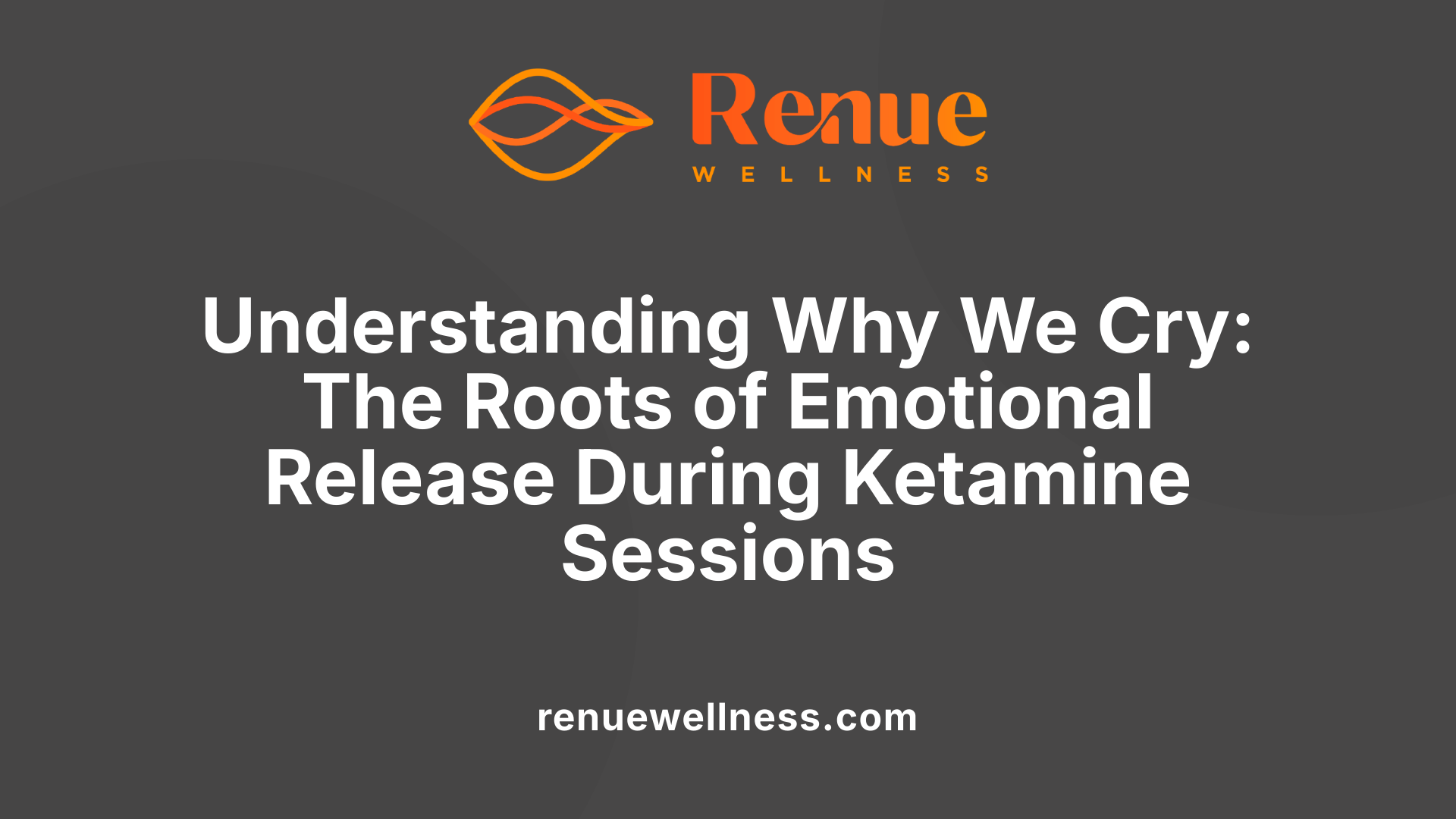Why Some People Cry During Ketamine Sessions (And That’s OK)


July 17, 2025
Exploring Why Tears Are Part of the Healing Journey
Ketamine therapy has gained recognition as an innovative treatment for various mental health conditions, notably depression and anxiety. While many patients undergo this treatment expecting relief and insight, a common and often surprising emotional response is crying. This article explores why some individuals experience tears during ketamine sessions, what these emotional reactions signify, and how they are fundamentally an integral part of the healing process.
The Physical and Emotional Sensations During Ketamine Therapy

What are some typical physical and emotional sensations experienced during ketamine therapy, including tears?
During ketamine therapy, patients often report a variety of physical sensations that contribute to the overall experience. Commonly, individuals describe feeling dissociated from their body or the environment, with sensations of floating or heaviness. These physical states can help shift awareness inward, fostering a space for emotional exploration.
Altered perceptions of time and space are also typical. Many patients feel as if time has slowed down or sped up, while others sense they are in a different dimension or universe. These perceptions can deepen the emotional journey, making space for significant insights and breakthroughs.
Emotionally, the therapy often unlocks feelings that have been suppressed or hidden. Patients may experience an intense release of repressed emotions like grief, anger, or sadness. Crying or tears are common, serving as a natural form of emotional catharsis. Tears indicate that the mind is processing stored-up feelings and toxins, aiding in emotional detoxification.
In addition, visual or auditory distortions can occur, such as seeing colors, patterns, or hearing gentle echoes. These sensory changes can enhance the feeling of being in a different realm or state of consciousness.
All these physical and emotional sensations work together to help patients access subconscious thoughts and feelings. This process often results in therapeutic breakthroughs—new perspectives, insights into past experiences, and feelings of relief or lightness. Such experiences are vital for emotional healing, making ketamine therapy a potent tool for processing complex emotions and fostering mental health recovery.
The Roots of Crying During Ketamine Sessions

Why do people often cry during ketamine therapy?
Crying during ketamine therapy is a common and natural response rooted in the treatment’s ability to deepen emotional processing. Ketamine acts like a bridge between the conscious and subconscious mind, dissolving mental barriers that usually keep suppressed feelings hidden. This openness allows underlying emotions—such as grief, joy, or relief—to surface in a safe environment.
During a session, the altered state of consciousness enhances emotional awareness. People often find themselves reconnecting with feelings they have long kept hidden or unexpressed. The release of these emotions, sometimes accompanied by tears, functions as an intrinsic excretory process, helping to rid the body and mind of stored-up distress or toxins.
Tears are not a sign of weakness but rather a sign that the process of healing is underway. They allow for emotional cleansing, clearing the way for mental clarity and well-being. This process is supported by the way ketamine influences brain regions responsible for emotion regulation and processing, such as the limbic system.
Recognizing tears as part of a healthy, therapeutic response encourages patients to accept their emotional reactions without fear or shame. Supporting and validating these releases can significantly enhance the overall benefits of ketamine therapy, fostering a sense of trust, safety, and progress in the healing journey.
Crying as a Normal and Healthy Part of the Treatment Process
Is crying a normal part of the ketamine treatment process?
Yes, crying is a common and natural aspect of ketamine therapy. It often reflects an emotional release, where deep-seated feelings or unresolved emotions rise to the surface. The dissolving of barriers between the conscious and subconscious mind allows patients to access hidden emotions, making crying a typical response.
Patients may cry from feelings of sadness, relief, joy, or even a sense of breakthrough. These tears are not signs of weakness but are viewed by healthcare professionals as a healthy response that indicates processing of stored emotions. Such emotional release can help clear emotional toxins that have built up over time, promoting healing and well-being.
Clinicians generally validate these emotional reactions, understanding that crying can be an integral part of the therapy’s effectiveness. After sessions, supporting patients to reflect on their feelings through discussion, journaling, or creative outlets can enhance their emotional processing. Overall, crying during ketamine treatment is seen as a sign that the therapy is working by facilitating access to and release of subconscious feelings.
Range of emotions expressed during therapy
During treatment, patients often experience a broad spectrum of emotions. These can include feelings of happiness, relief, sadness, or even hopelessness. Such emotional variability is considered part of the healing process.
In some cases, crying can occur during moments of profound insight or breakthrough, helping to solidify new perspectives or release long-held pain. These emotional shifts, whether toward joy or sorrow, facilitate a deeper connection with oneself and promote mental and emotional resilience.
Validating emotional releases to promote trust
Healthcare providers play a crucial role in recognizing and validating tears as a sign of emotional working, which can foster a sense of safety and trust. Acknowledging these responses encourages patients to open up and engage more fully with their healing process.
Post-session emotional processing, through coaching, journaling, or artistic expression, can further integrate the experience. This ongoing reflection supports sustained emotional release and long-term recovery.
Supportive practices after session
To maximize therapeutic benefits, patients are encouraged to process their emotions after sessions. Reflective activities such as journaling, art, or talking with a therapist can help make sense of the feelings that surfaced during treatment. Creating a supportive environment during and after therapy ensures that the emotional releases contribute to meaningful progress.
Crying during ketamine therapy is not only normal but also a sign of the treatment's potential to unlock and heal buried emotions, ultimately aiding patients on their journey toward mental wellness.
The Significance of Tears in Emotional and Psychological Healing
What is the emotional and psychological significance of tears during ketamine therapy?
Tears during ketamine therapy are more than just physical reactions; they carry deep emotional and psychological meaning. Often, they symbolize an intense release of emotions that may have been trapped or suppressed for years. This process allows unconscious feelings, memories, or traumas to surface into consciousness, making them accessible for healing.
The act of crying in this context indicates that therapy is effectively breaking down mental barriers. Ketamine’s unique ability to dissolve the divide between the conscious and unconscious mind facilitates emotional access, enabling patients to confront and process difficult feelings.
Such tears can express a wide spectrum of emotions—from profound sadness and grief to overwhelming joy and relief. Sometimes, they mark the overcoming of despair, signaling a turning point towards hope and recovery.
The emotional release achieved through crying during therapy echoes the idea of emotional cleansing or washing away pain. It’s akin to an excretory process for feelings that have been stored up, stagnant, or unacknowledged.
In essence, tears serve as a visible and powerful sign that healing is underway. They not only symbolize emotional breakthrough but also positively impact well-being by facilitating emotional washing away and helping individuals process their inner experiences. This natural and profound response makes crying during ketamine therapy a vital part of the journey towards mental and emotional restoration.
Crying and Emotional Reaction as Indicators of Therapeutic Progress

Can crying or other emotional reactions during ketamine sessions indicate progress or therapeutic benefit?
Crying during ketamine therapy is often viewed as a natural part of the emotional release process facilitated by the treatment. As ketamine dissolves the barriers between conscious and unconscious thoughts, individuals are more likely to access and express deep-seated emotions such as sadness, fear, or joy. This emotional release acts as a form of excretion, helping to clear stored-up feelings and toxins from the nervous system.
Research supports that such reactions are signs of emotional processing, with tears acting as an excretory mechanism for underlying feelings. These emotional cues suggest that the therapy is helping the brain to process and release suppressed emotions, which is essential for healing.
Over time, studies show that ketamine can normalize activity in brain regions governing emotional regulation. As emotional responses stabilize, patients often experience enhanced emotional resilience and reduced reactivity to stressors.
Clinicians also look for subtle signs during sessions, such as softer self-talk, increased motivation, or a sense of relief, which may indicate ongoing progress. Formal assessments, combined with the patient’s subjective reports of emotional breakthroughs, provide a comprehensive view of recovery.
While not every emotional reaction guarantees success, shedding tears or experiencing feelings of joy during ketamine therapy typically signifies that meaningful emotional work is underway. Such experiences demonstrate that the treatment is effectively enabling individuals to confront and process difficult feelings, fostering long-term emotional health.
In addition to emotional responses, brain activity patterns—such as increased connectivity between emotional and cognitive centers—support these therapeutic benefits. As sessions progress, emotional stability improves, and the individual becomes better equipped to handle future stressors.
Supporting these processes, post-session activities like therapy discussions, journaling, or creative expression serve as valuable tools to further integrate emotional insights gained during treatment. Collectively, these approaches can enhance the therapeutic journey and promote sustained emotional well-being.
Supporting Emotional Reactions During and After Ketamine Therapy

What should individuals or healthcare providers understand about emotional responses like crying during ketamine treatment?
Crying during ketamine therapy is a natural, often helpful part of emotional processing. It usually signifies that underlying feelings are surfacing and being released, which is essential for healing. Rather than viewing tears as a sign of distress, it’s important to see them as an indicator of progress, where emotional barriers are dissolving.
Ketamine’s unique ability to access the subconscious mind allows suppressed emotions—such as sadness, anger, or even joy—to emerge openly. This process helps clear emotional blockages and facilitates a healthier mental state. When patients cry during sessions, it’s often a sign that the therapy is working as intended.
Creating a safe, calm, and supportive environment enhances this process. Music, comforting surroundings, and positive affirmations help patients feel secure enough to express these emotions freely. Support from therapists and loved ones plays a crucial role in validating tears as part of the healing journey.
Post-session activities such as discussion, journaling, or art provide avenues for integrating these emotional releases. It’s essential for caregivers and clinicians to guide individuals through processing what has come up, helping them understand that crying is a normal, healthy response.
In summary, understanding that emotional reactions like crying are part of the therapeutic process encourages openness and emotional bravery, ultimately leading to more meaningful healing outcomes.
Normalizing and Embracing Emotional Expression in Ketamine Therapy
Recognizing that crying and other emotional reactions are common and beneficial parts of ketamine therapy can help demystify the process and foster a supportive environment for healing. These emotional releases serve as vital signs of progress, offering insights into deep-seated feelings and traumas that are ready to be addressed. By validating such responses and supporting emotional processing, clinicians and patients work together towards meaningful recovery. Embracing tears as a natural aspect of the therapeutic journey reinforces the idea that emotional vulnerability is not only safe but essential for genuine healing and growth.
References
- Understanding Crying During Ketamine Therapy - A Mind's Journey
- Why Your Patient Is Crying During Ketamine Treatments
- Understanding and Addressing Crying During Ketamine Infusion
- Why You Are Crying During Ketamine Therapy
- How to Reassure Your Ketamine Patients Before An Infusion
- Safety of IV Ketamine - What Do We Know About Repeated Infusions?
- During Ketamine Therapy: What To Do & What To Expect
- How Ketamine Feels - Field Trip Health
- New questions about ketamine therapy after actor Matthew Perry's ...
- When a Ketamine Therapy Visit Goes Horribly Wrong
Recent Posts
Conditions Treated
AnxietyDepressionOCDPTSDPostpartum DepressionPain ManagementSubstance AbuseSuicidal IdeationOur Location


